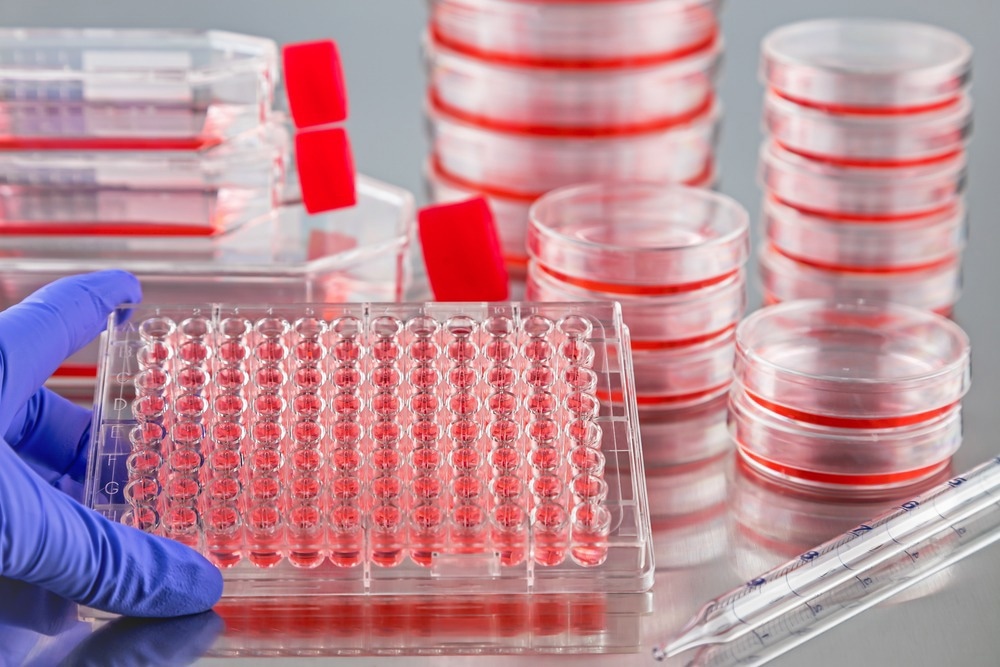Cell culture is traditionally a manual laboratory process typically used to produce cells and cellular products. In this article, AZoRobotics looks at how robots are being applied to this process.

Image Credit: Hakat/Shutterstock.com
What is Cell Culture?
The cell culture process is known to be repetitive and time-consuming, with meticulous laboratory protocols that prioritize sterility above all. Additionally, as a result of using living cells, which require favorable environments for optimum growth, scientists are required to partake in processes to ensure maximum survival and comfort for cells, including changing medium, harvesting, passaging, reseeding and analysis.
Cell culture requires passaging of cells when a confluence level of 70-80% is reached, requiring the cells to be split between two or more flasks to provide them with more space to grow effectively. The use of robots that are able to automate this process can eliminate subjective judgment of processing decisions with process parameters, settings and timings being determined and set. Automated image acquisition and processing can provide a foundation for adaptive processing based on objective criteria determining confluency, which is usually determined subjectively by the operator.
Tecan
Tecan, a leading global player in the life sciences industry, has produced a novel automated system that enables the handling of tissue cultures in microplate-sized cell culture flasks, that is automation-friendly. The Flask Flipper module has been introduced by recognized consumable manufacturers, such as the RoboFlaskTM vessel by Corning Life Sciences.
The use of this module has removed and alleviated many challenges from the traditional cell culture method through automating processes such as harvesting, passaging, as well as splitting and seeding adherent cells. Interestingly, studies that have carried out a comparison of manual and automated cell culture, have shown no statistical differences in cell count or viability when harvested, which demonstrates the significant advantage cell culture automation can have to save time without compromising efficacy.
Benefits of Automation
Automating processes within the cell culture of mammalian cell lines holds many benefits, including making this originally time-consuming procedure more streamlined and faster. Without the involvement of humans, scientists can utilize their time for other pressing matters within the research process, such as for analysis, without also worrying about the human error of cell culture that can sometimes result in cell death and starting experiments again.
Additionally, the automation of cell culture can ensure the scheduling of the experiment is not compromised due to weekends, vacations and sick days, while also alleviating repetitive strain and injury and variability from batch to batch.
The automation of cell culture can increase the ability to scale research, without human limitations as well as significantly reduce the time of the entire process before products can be marketed.
Challenges
While automation of cell culture can be effective and save an extraordinary amount of time, the number of companies that produce fully automated cell culture systems is small.
This is due to the nature of being fully automated, which would require an environment for cells to grow and the ability to monitor cell growth without the need for human interaction. Additionally, these systems should allow unattended operation over a long time period, such as days and weeks, as well as allow for evaluation of variables, including, pH, nutrient or waste concentration, cell concentration and viability. These systems work in a manner in which fresh media can be added periodically, and spent media with metabolic waste products are removed.
Other challenges for automated cell culture can include associated high expenditure, with companies that are undergoing a significant amount of research requiring many automated systems for each laboratory and this may not be feasible due to cost. However, it can be argued that the use of consumables, reagents, and equipment required for manual cell culture, as well as employee costs can also result in high expenditure. Automated systems can aid in streamlining conventional processes and cut costs for employees and many different types of equipment.
Other Robotics Systems
With research and development into automated systems for cell culture and scientific processes, many companies have produced robotic systems that challenge and improve conventional laboratory processes.
A company called Cytogration has developed a robotic system that carries out both cell culture as well as high throughput screening assays; this system can handle up to 504 multi-well plates, with three incubators. It is also able to automate processes, including plate coating, seeding, cell feeding, as well as automated incubation assays that are useful in compound selection, such as for drug discovery.
Future Outlook
With more processes becoming automated with the use of robotics, this can save human time and also ensure employees are not overworked or stressed due to the tight time constraints associated with laboratory schedules, such as for cell culture, which may require coming in during weekends, and days off to passage, or change medium.
Additionally, the use of robotics in automated cell culture can also alleviate human error and increase accuracy and efficacy in these processes, with sterility and objective criteria and consistency being prioritized, and well as having the least amount of variability. This can result in more successful experimentation, with successful outcomes in many fields, from cell and gene therapies to drug discovery.
Overall, the use of robots in automated cell culture can advance laboratory techniques and processes and may even lead to more successful research.
References and Further Reading
Automated Cell Culture from Tecan. [Online] Tecan Group Home. Available at: https://www.tecan.com/customer-news/automated-cell-culture-from-tecan-2270.
Kempner, M.E., & Felder, R.A., (2002) A review of Cell Culture Automation. JALA: Journal of the Association for Laboratory Automation. 7(2), pp. 56-62. https://journals.sagepub.com/doi/10.1016/S1535-5535-04-00183-2.
Moutsatsou, P., Ochs, J., Schmitt, R.H., Hewitt, C.J. & Hanga, M.P., (2019) Automation in cell and gene therapy manufacturing: From past to future. Biotechnology letters. https://pubmed.ncbi.nlm.nih.gov/31541330/.
Disclaimer: The views expressed here are those of the author expressed in their private capacity and do not necessarily represent the views of AZoM.com Limited T/A AZoNetwork the owner and operator of this website. This disclaimer forms part of the Terms and conditions of use of this website.